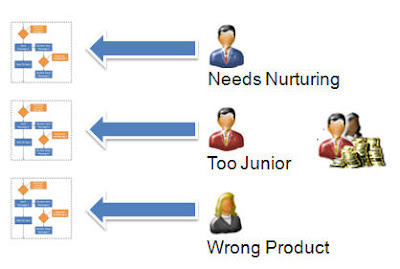 Recently, we talked about the need to implement a claw-back system for scored leads that are passed to sales and show no sales activity. This approach is useful, but is a black and white system. Either a lead is good and is worked by sales, or it is not good and is ignored and quickly clawed back. There is no opportunity for middle ground, and no opportunity for feedback from sales.
Recently, we talked about the need to implement a claw-back system for scored leads that are passed to sales and show no sales activity. This approach is useful, but is a black and white system. Either a lead is good and is worked by sales, or it is not good and is ignored and quickly clawed back. There is no opportunity for middle ground, and no opportunity for feedback from sales.If, instead, the sales team is presented with disposition options for the lead that feed directly into appropriate lead nurture campaigns, the best of both worlds is achieved. By having an option to pass a lead back to marketing, with a specific disposition that guides what will happen next, the sales person is able to maintain ownership of the lead. However, by carefully constructing the set of disposition options, marketing can learn much more about why the leads were not accepted by sales than they ever would have by asking sales to fill out a feedback form.
For example:
- If a lead is deemed by sales to be slightly too early in their buying process, they might enter the lead into a “Late Stage Buyer Nurturing” lead nurture program that provides case studies and ROI analysis to guide a prospect towards buying
- If a lead is deemed by sales to be too junior to make a buying decision, they might enter the lead into a “Convince Your Executive Team” nurture program that provided key information to make an internal business case for your solution
- If a lead is deemed by sales to be more interested in an alternate product (Product B), they might enter the lead into a “Product B Nurturing” program
These are only a few examples, each organization will have different options. The technique of providing these “lead disposition” options to sales in order to provide sales with a “middle ground” option, while at the same time providing rich insights to your marketing team as to why a lead is being rejected is extremely valuable.
This question is one of 8 critical lead scoring questions to consider when thinking about a lead scoring system.















0 komentar:
Post a Comment